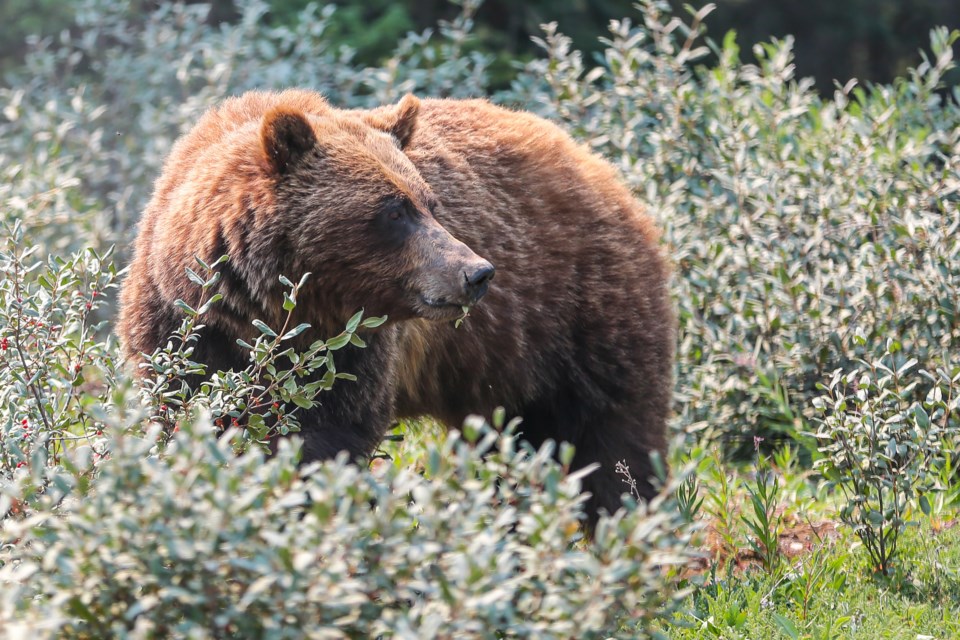BANFF – Busy roads and highways are taking a deadly toll on grizzly bears in the mountain national parks this spring.
Three grizzly bears have been killed on the roads in Yoho and Jasper national parks in the past three weeks, including a female grizzly bear in Jasper on June 16 that left behind an orphaned cub.
A male grizzly bear was struck and killed on the Trans-Canada Highway in Yoho National Park on June 11, just four days after a five-year-old female grizzly bear – the sibling of the rare white grizzly bear – was killed on the same stretch of deadly highway.
Parks Canada wildlife experts say the slow start to spring and lingering snowpack are keeping food-driven bears at lower elevations in search of much-needed vegetation like green grass and dandelions for longer than usual.
“This is exposing them to more risk along roadsides that they’re using as a good food source,” said David Laskin, wildlife ecologist for Lake Louise, Yoho and Kootenay field unit.
The death of the female grizzly on June 7 led to implementation of a no-stopping zone and reduced speed limit of 70km/h on the Field hill between Sherbrooke Creek and Yoho Valley Road.
The speed limit was further dropped to 50 km/h following the death of the male bear last week.
Parks Canada and the RCMP have beefed up enforcement in the area. So far, 116 speeding tickets and four tickets for violation of the no-stopping zone have been issued.
The RCMP have also impounded five vehicles to date along that stretch of highway for going more than 40 km/h over the posted speed limit.
Laskin said stopping creates traffic hazards that are dangerous to passing vehicles and increases danger to wildlife through habituation to people and vehicles, noting traffic congestion can increase the chance of wildlife being struck on the road.
He said obeying the speed limit is important to help prevent wildlife mortality, but it also aims to protect travellers as well as Parks Canada staff who are working beside the road trying to eliminate vegetation such as dandelions or haze away bears.
“These roadside bears are challenging to manage so we really appreciate the support of visitors and travellers in helping us by obeying the speed limits and not stopping when they see bears,” said Laskin.
The large male grizzly bear that met its premature fate on June 11 was previously unknown to Parks Canada.
“It was recently seen in the company of the well-known white bear and the female sibling that was killed about three or four days earlier,” said Laskin.
Parks Canada continues to work around the clock to protect the rare white grizzly and other bears.
Bear experts have previously determined the white bear is not albino – mutations of certain genes that affect the amount of melanin, which controls the pigmentation of skin, eyes and hair – but likely the rare colour is caused by a recessive gene that makes fur white.
Laskin said the white bear has continued to hang out roadside in Yoho National Park, but is also venturing east towards Lake Louise in Banff National Park.
“When this white bear is approaching the fences, our staff respond very quickly to push that bear back and let it know that this isn’t a safe place for it to be,” he said.
The risk to the white bear is exacerbated by her ability to climb the highway wildlife exclusion fence, which is something not typically seen with grizzly bears but more with black bears.
Parks Canada hopes the five-year-old bear outgrows her roadside behaviour and becomes more of a backcountry bear like her mom was. Her mom, bear No. 156, was killed last year on the highway.
“We’re hoping that she outgrows this behaviour, which we’ve seen in other bears,” said Laskin.
“As they get a bit older, they don’t use the roadway in the same way and become more wary. We’re hoping the same for this bear.”
An adult grizzly bear was struck by a train on the Canadian Pacific Railway about eight kilometres west of Lake Louise on May 12. While Parks Canada suspects it was a male, that is inconclusive at this time.
A male black bear was hit and killed on the Trans-Canada Highway west of Field on June 13.
Meanwhile, in Kootenay National Park, Parks Canada has been monitoring a female grizzly bear and her two young-of-year cubs that have been hanging out in the Olive Lake area at the southern end of the park this spring.
Laskin said one of the cubs had been showing signs of illness and died on June 14.
He said tests will be conducted to determine the exact cause of death, but noted natural mortality is not uncommon for neonate bears.
“It could be a multitude of things, not excluding a parasite, but we won’t speculate until we know,” said Laskin.
“It looked lethargic, and was kind of lagging behind the mother and other cub, and it was growing more ill… there were general signs of illness such as diarrhoea.”
Grizzly bears are listed as threatened in Alberta and ranked as S3 (Vulnerable Uncertain) in B.C.
Parks Canada asks that any bear sightings be immediately reported to Banff National Park dispatch at 403-762-1470.




